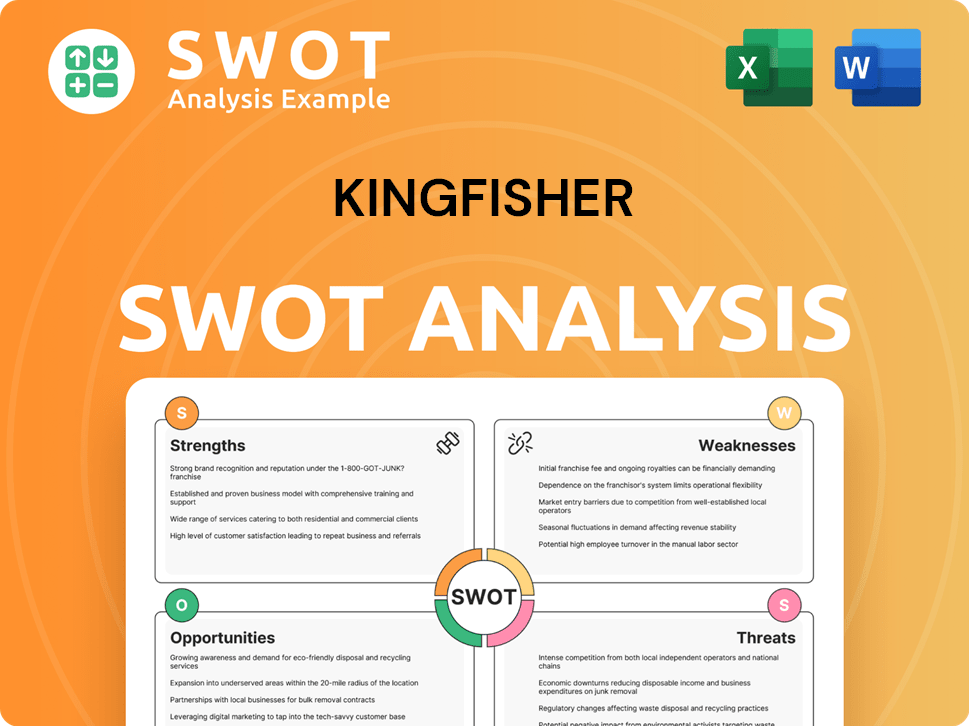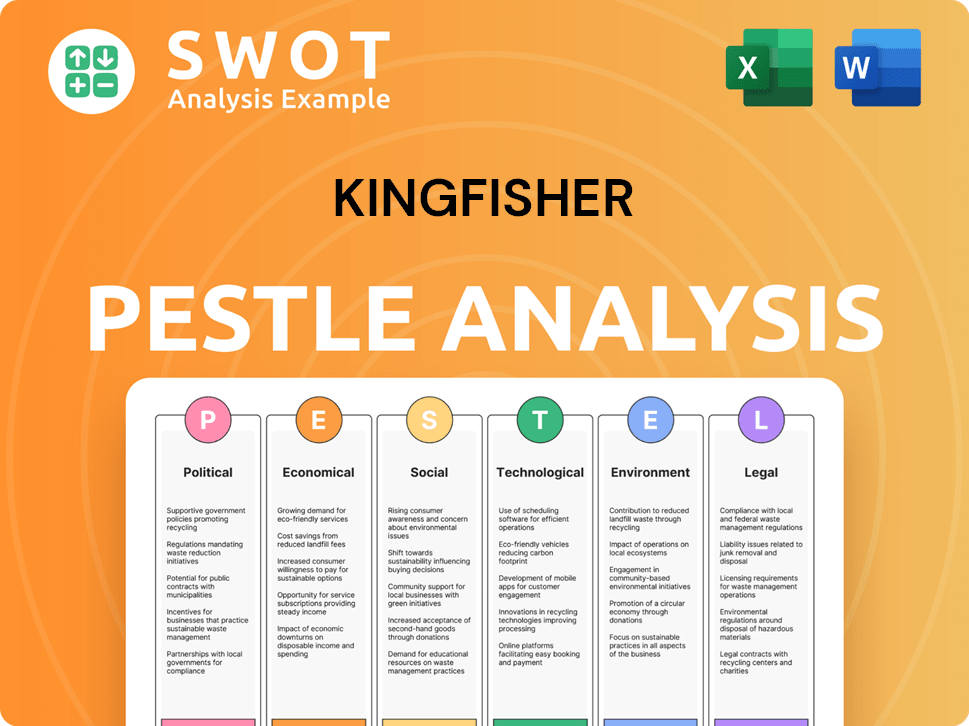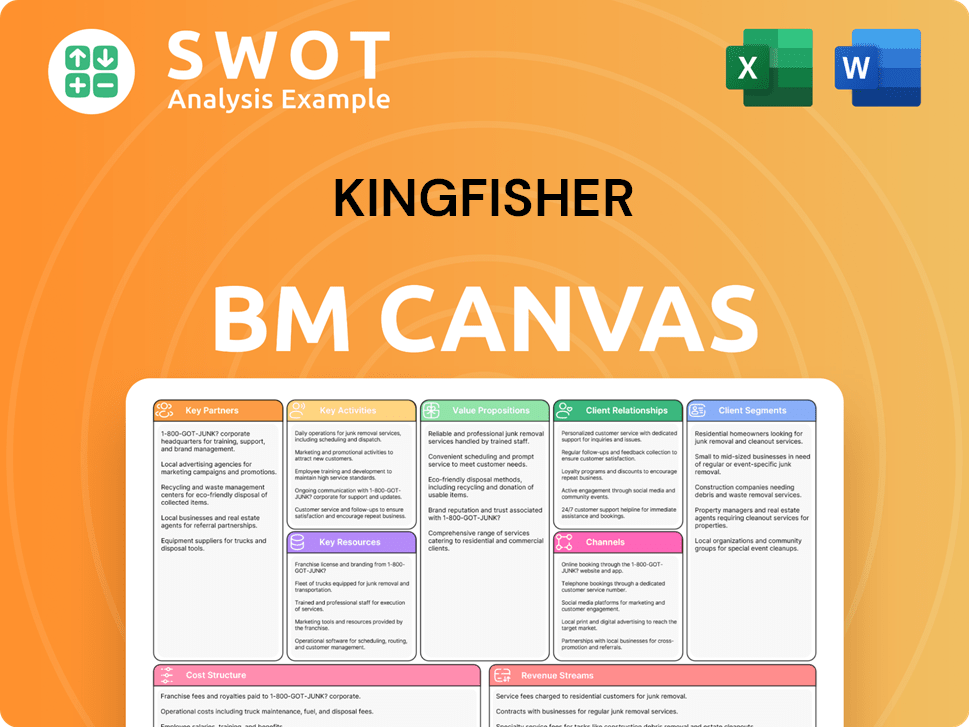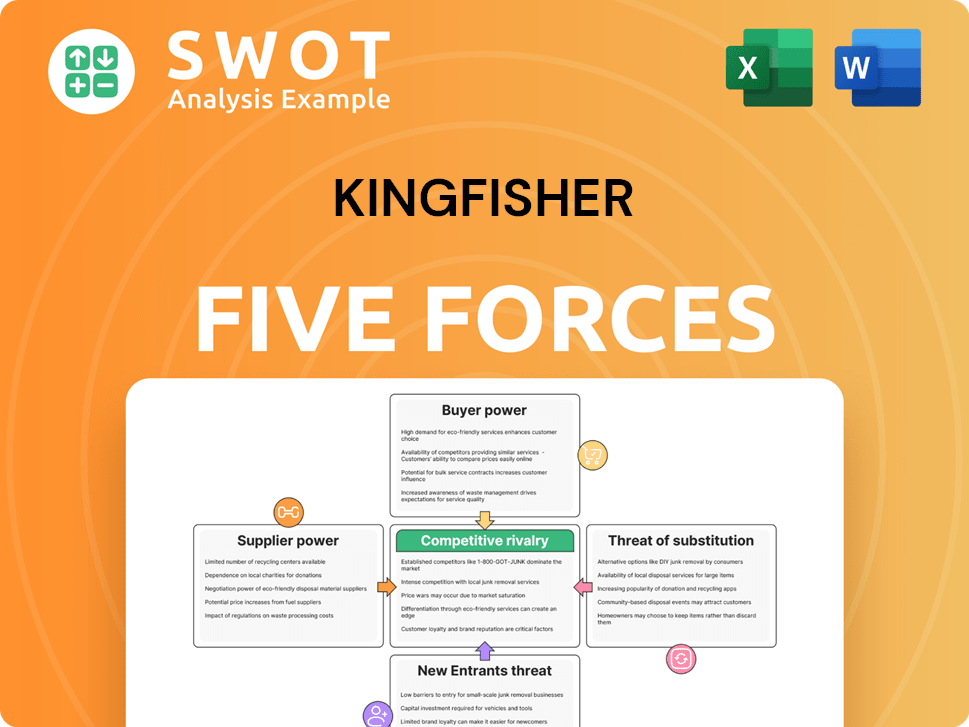Kingfisher Bundle
Decoding Kingfisher's Customer: Who Buys and Why?
In a market as dynamic as home improvement, understanding the Kingfisher SWOT Analysis is crucial. The home improvement sector's recent boom highlights the need for companies like Kingfisher to deeply understand their customer demographics and target market. This knowledge is not just a competitive edge; it's the cornerstone of a successful business strategy. Kingfisher, an international home improvement giant, operates over 1,300 stores across Europe, making it essential to know who their customers are.

Kingfisher's journey from a basic DIY supplier to a sustainable home improvement provider reflects a keen understanding of its evolving customer base. Initially focused on homeowners, the company now navigates a diverse market, adapting to trends like digital integration and sustainability. This continuous refinement allows Kingfisher to effectively serve its target market, ensuring it remains relevant in a competitive landscape. Understanding the customer demographics and target market is key to Kingfisher's continued success, influencing everything from product development to marketing campaigns. The Kingfisher company must constantly analyze market segmentation and consumer profile to thrive.
Who Are Kingfisher’s Main Customers?
The primary customer segments of the Kingfisher company are diverse, with a significant focus on the Business-to-Consumer (B2C) market. This includes a broad demographic, ranging from young adults to older homeowners, all interested in home improvement projects. The company also caters to the Business-to-Business (B2B) sector, particularly through its trade-focused banners like Screwfix, which serve small and medium-sized enterprises (SMEs) in the building and trade industries.
For its B2C operations, Kingfisher's customer demographics span a wide age range, income levels, education, and occupations. This reflects the broad appeal of home improvement across different socio-economic groups. Family status also plays a role, influencing the types of products customers seek, whether for home expansion or smaller aesthetic upgrades. Understanding the Brief History of Kingfisher helps to grasp its evolution in catering to these diverse segments.
In 2024, Kingfisher's trade segment, including Screwfix, demonstrated strong performance, increasing its market share. This growth indicates a robust B2B customer base, which constitutes a significant and increasing portion of the company's revenue. These trade customers, primarily professional builders, plumbers, and electricians, prioritize convenience, product availability, and efficient service. Within the B2C segments, there's a continued demand for sustainable products and digital shopping experiences, highlighting a shift towards environmentally conscious and tech-savvy consumers.
Kingfisher's customer base is broad, encompassing various age groups and income levels. The target market includes both DIY enthusiasts and trade professionals. The company's market segmentation caters to diverse needs, from budget-conscious consumers to those seeking premium products.
The B2B segment, especially through Screwfix, is crucial, serving SMEs in the building and trade sectors. These customers value convenience, product availability, and efficient service. This focus has driven significant revenue growth in recent years.
There's a growing demand for sustainable products and digital shopping experiences among B2C customers. Kingfisher is adapting to these trends by expanding its product lines and enhancing digital platforms. Customers are increasingly focused on 'repair, maintain, and improve' projects.
Kingfisher's market segmentation strategy involves tailoring offerings to different income levels and project types. The company's approach to market segmentation allows it to effectively target a broad range of consumers. This strategy supports its ability to meet diverse customer needs.
Kingfisher's primary customer segments include both B2C and B2B clients, with a focus on home improvement. The B2C segment includes a wide demographic, while the B2B segment targets trade professionals.
- Young adults and older homeowners are key in the B2C segment.
- Professional builders, plumbers, and electricians are essential in the B2B segment.
- Demand for sustainable products is rising among consumers.
- Digital shopping experiences are increasingly important for customer satisfaction.
Kingfisher SWOT Analysis
- Complete SWOT Breakdown
- Fully Customizable
- Editable in Excel & Word
- Professional Formatting
- Investor-Ready Format

What Do Kingfisher’s Customers Want?
Understanding the customer needs and preferences is crucial for the success of the Marketing Strategy of Kingfisher. These needs are diverse, encompassing practical requirements, aesthetic desires, and an increasing emphasis on sustainability. The purchasing decisions of the customers are shaped by project specifics, budget considerations, and the demand for high-quality, long-lasting products.
Customers are driven by a desire to create comfortable, functional, and visually appealing living spaces. They seek solutions to everyday home challenges, such as energy efficiency, storage, and ease of maintenance. Many are also motivated by aspirations to enhance their property's value or to achieve their dream home.
Common pain points addressed by the company include the complexity of large projects, the need for expert advice, and the availability of specific parts or tools. Customer feedback and market trends, especially the growing focus on environmental responsibility, have significantly influenced product development.
Customers need products that are practical, aesthetically pleasing, and sustainable. They seek solutions for home improvement projects that are both effective and easy to use. The demand for high-quality, durable products remains a constant driver.
Customers are motivated by the desire to improve their living spaces and increase their property value. They seek to create comfortable, functional, and aesthetically pleasing homes. Personalization and the ability to express individual style are also key motivators.
Customers prefer products that offer a balance of cost, ease of use, and product longevity. They value brands with a strong reputation and reliable customer support. Convenience, such as online shopping and home delivery, is increasingly important.
Purchasing behavior is influenced by project scope and budget. Customers often research products extensively and compare prices. The decision-making process involves considering factors like product features, warranty, and brand reputation.
Loyalty is driven by positive in-store and online experiences, reliable product performance, and effective customer support. Repeat purchases are common when customers are satisfied with the product quality and service. Loyalty programs and personalized offers also play a significant role.
Customers are psychologically motivated by the desire for self-expression and the creation of a comfortable living environment. They seek to solve practical problems and improve their quality of life. The emotional connection to their homes influences their choices.
Several key trends significantly impact customer preferences and inform the company's product development and marketing strategies. These trends include the increasing importance of sustainability, the demand for convenient omnichannel shopping experiences, and the need for expert advice and support.
- Sustainability: The company is increasingly focusing on offering sustainable home improvement solutions, with sales of such products reaching 58% of total sales in 2023/2024, up from 55% the previous year. This demonstrates a strong response to the growing customer demand for eco-friendly products.
- Omnichannel Experience: Enhancements to the digital presence and online services, including click & collect and home delivery options, cater to customers who value convenience. This omnichannel approach ensures a seamless shopping experience.
- Expert Advice and Support: Providing expert advice and support through in-store staff, online resources, and project planning tools addresses the pain points customers face when undertaking home improvement projects. This helps customers make informed decisions and ensures project success.
- Product Innovation: Continuous innovation in product design and functionality, such as smart home solutions and energy-efficient appliances, meets the evolving needs of customers. This includes offering products that enhance both the functionality and aesthetics of living spaces.
- Community Engagement: The company engages with local communities through workshops and events to build brand loyalty and understand customer needs better. This fosters a strong connection with customers and provides valuable insights for product development.
Kingfisher PESTLE Analysis
- Covers All 6 PESTLE Categories
- No Research Needed – Save Hours of Work
- Built by Experts, Trusted by Consultants
- Instant Download, Ready to Use
- 100% Editable, Fully Customizable

Where does Kingfisher operate?
The geographical market presence of the [Company Name] is primarily centered in Europe, where it operates over 1,300 stores across eight countries. This extensive network underscores the company's commitment to the home improvement and DIY sector within the European market. Key markets include the UK, Ireland, France, Poland, and Iberia, each contributing significantly to the company's overall sales and market share.
The company's success is underpinned by its strong brand recognition and market share, particularly in the UK and France, which are its largest markets. The company strategically adapts its offerings and marketing strategies to suit the local customer demographics and preferences in each region. This localized approach is crucial for maintaining a competitive edge and driving growth in diverse markets.
In the financial year 2023/2024, the UK & Ireland accounted for sales of £6,854 million, while France reported sales of £4,260 million. These figures highlight the importance of these markets to the company's financial performance. The company continues to invest in expanding its digital capabilities and optimizing its store network to capture further growth across all regions.
The company employs market segmentation to tailor its products and services to different customer groups. This includes understanding the diverse needs and preferences of consumers in various geographical locations. For example, the DIY culture in the UK differs from the aesthetic focus in France.
Understanding the consumer profile in each market is crucial. This involves analyzing factors such as age, income, lifestyle, and homeownership rates. The company uses this data to create targeted marketing campaigns and product assortments. The company's customer demographics vary across regions.
The company adapts its product offerings, marketing strategies, and partnerships to suit local market conditions. This includes tailoring product assortments to local tastes and establishing partnerships with local suppliers. For instance, in Poland, the company offers products that cater to local housing types.
The continued investment in the Screwfix banner, with successful expansion into new territories like France and Poland, demonstrates a targeted market entry strategy for its trade-focused segment. This expansion strategy is a key component of the company's growth plans. This strategy is a key part of the company's growth plans.
The geographic distribution of sales indicates strong performance in core markets, with ongoing efforts to optimize the store network and expand digital capabilities across all regions. The company is focusing on enhancing its online presence to meet evolving consumer preferences. The company's sales are geographically diverse.
The company identifies its ideal customer by analyzing demographics, psychographics, and consumer behavior. This helps in designing effective marketing campaigns and product development strategies. The company's target market strategy is data-driven.
Kingfisher Business Model Canvas
- Complete 9-Block Business Model Canvas
- Effortlessly Communicate Your Business Strategy
- Investor-Ready BMC Format
- 100% Editable and Customizable
- Clear and Structured Layout

How Does Kingfisher Win & Keep Customers?
The focus of the [Company Name] on customer acquisition and retention is multifaceted, encompassing both traditional and digital strategies. These strategies are designed to reach a broad customer base by leveraging various marketing channels. The company employs a mix of digital campaigns, including search engine marketing, social media advertising, and email marketing, alongside traditional advertising methods like television and print media. This integrated approach helps in reaching a diverse target market.
The company also utilizes influencer marketing, particularly engaging DIY bloggers and home improvement enthusiasts to connect with specific consumer segments. Furthermore, loyalty programs and personalized experiences are vital for retaining customers. These programs offer exclusive discounts and tailored offers, encouraging repeat purchases and enhancing customer lifetime value. After-sales service, including product guarantees and customer support, also plays a key role in building trust and satisfaction.
The "Powered by [Company Name]" strategy emphasizes strengthening omnichannel retail capabilities, which is a critical element in both acquiring and retaining customers. In 2023/2024, omnichannel sales represented 18% of total sales. Click & collect sales grew by 13% in Q4 2023/2024, highlighting the success of this integrated approach. The company's adaptability, such as investing in improved online platforms and supply chain efficiencies, directly impacts customer satisfaction and retention rates.
Extensive digital campaigns are used, including search engine marketing, social media advertising, and email marketing to acquire new customers. These campaigns are designed to increase brand visibility and drive traffic to online platforms and physical stores. The strategy aims to capture a broad customer base.
Traditional advertising methods such as television and print media are still utilized to reach a wider audience. These methods are often used to complement digital efforts, ensuring comprehensive market coverage. This approach helps maintain brand awareness and reach customers who may not be as active online.
Influencer marketing, particularly involving DIY bloggers and home improvement enthusiasts, targets specific customer segments. This strategy helps in building trust and credibility by leveraging the influence of trusted voices within the industry. It is a targeted approach to reach specific demographics.
Loyalty programs, like B&Q Club in the UK, offer exclusive discounts, personalized offers, and early access to sales. These programs foster repeat purchases and increase customer lifetime value. They are essential for retaining existing customers and building long-term relationships.
The strategic use of customer data and CRM systems enables tailored marketing messages and product recommendations. This personalization enhances the customer experience and increases the likelihood of repeat purchases. It is a data-driven approach to customer engagement.
After-sales service, including product guarantees, returns policies, and customer support, is crucial for building trust and ensuring customer satisfaction. These services help in maintaining a positive brand image and encouraging customer loyalty. It is an essential component of customer retention.
The "Powered by [Company Name]" strategy emphasizes strengthening omnichannel retail capabilities, integrating online and offline channels. This approach allows customers to shop seamlessly across different platforms. This integration is a key element for customer acquisition and retention.
Click & collect sales grew by 13% in Q4 2023/2024, demonstrating the effectiveness of the integrated online and offline approach. This growth highlights the convenience and appeal of this service to customers. It is a significant indicator of customer satisfaction.
The company consistently adapts its strategies by investing in improved online platforms and supply chain efficiencies. These investments directly impact customer satisfaction and retention rates. This adaptability is crucial for staying competitive in the market.
The core focus is on ensuring product availability and timely delivery to enhance customer satisfaction. This strategy directly contributes to building customer loyalty and encouraging repeat business. It is a fundamental aspect of their business model.
Competitive pricing and promotional offers are used to drive conversions and attract new customers. These strategies are designed to make products more appealing and accessible. They are a key component of the sales tactics.
In-store expertise and knowledgeable staff help in providing excellent customer service. This approach ensures that customers receive the assistance they need to make informed purchasing decisions. It is essential for building customer trust and loyalty.
The [Company Name] employs a comprehensive suite of customer acquisition and retention strategies. These strategies include digital marketing, traditional advertising, and loyalty programs. They are designed to engage a diverse customer base and drive sales.
- The company's approach combines various marketing channels to reach a wide audience.
- Digital campaigns, such as search engine marketing and social media advertising, are key components.
- Traditional advertising methods, like television and print media, are also used.
- Loyalty programs are crucial for retaining customers and fostering repeat purchases.
For a deeper understanding of the competitive landscape, consider reading about the Competitors Landscape of Kingfisher.
Kingfisher Porter's Five Forces Analysis
- Covers All 5 Competitive Forces in Detail
- Structured for Consultants, Students, and Founders
- 100% Editable in Microsoft Word & Excel
- Instant Digital Download – Use Immediately
- Compatible with Mac & PC – Fully Unlocked

Related Blogs
- What are Mission Vision & Core Values of Kingfisher Company?
- What is Competitive Landscape of Kingfisher Company?
- What is Growth Strategy and Future Prospects of Kingfisher Company?
- How Does Kingfisher Company Work?
- What is Sales and Marketing Strategy of Kingfisher Company?
- What is Brief History of Kingfisher Company?
- Who Owns Kingfisher Company?
Disclaimer
All information, articles, and product details provided on this website are for general informational and educational purposes only. We do not claim any ownership over, nor do we intend to infringe upon, any trademarks, copyrights, logos, brand names, or other intellectual property mentioned or depicted on this site. Such intellectual property remains the property of its respective owners, and any references here are made solely for identification or informational purposes, without implying any affiliation, endorsement, or partnership.
We make no representations or warranties, express or implied, regarding the accuracy, completeness, or suitability of any content or products presented. Nothing on this website should be construed as legal, tax, investment, financial, medical, or other professional advice. In addition, no part of this site—including articles or product references—constitutes a solicitation, recommendation, endorsement, advertisement, or offer to buy or sell any securities, franchises, or other financial instruments, particularly in jurisdictions where such activity would be unlawful.
All content is of a general nature and may not address the specific circumstances of any individual or entity. It is not a substitute for professional advice or services. Any actions you take based on the information provided here are strictly at your own risk. You accept full responsibility for any decisions or outcomes arising from your use of this website and agree to release us from any liability in connection with your use of, or reliance upon, the content or products found herein.